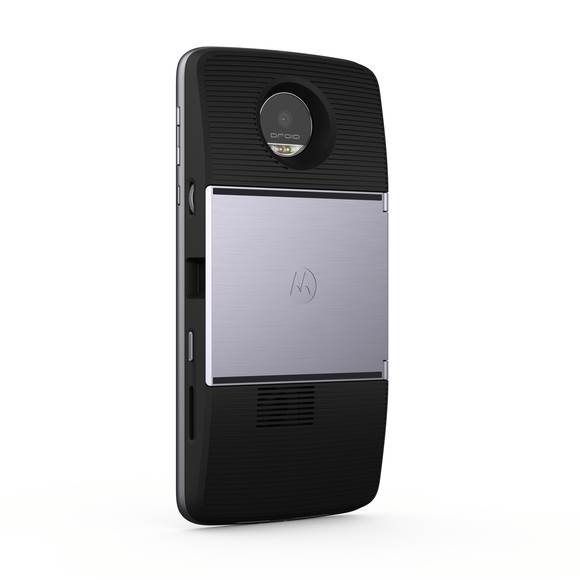Lenovo has made a big bet on the concept of a modular smartphone.
The company’s subsidiary, Motorola, recently began selling the Moto Z and Moto Z Force as Verizon exclusives (unlocked versions are coming later) that can be paired with a series of snap-on modules.
The concept is that you can easily add on a battery pack, set of speakers, or even a projector. But along with the initial run of mods, Motorola hopes to tap into the “maker” community by encouraging more modules with its Moto Mods Development Kit.
You can buy a few module add-ons now, with the snap-on projector being the one most likely to grab attention at your next dinner party (though it’s pricey at $300).
Modules aren’t new. The LG G5 tried its own set of “Friends,” while case maker Otterbox built a large number of partners for its Universe Case System.
Motorola thinks it has something different, even offering a behind-the-scenes look recently at the thinking with Moto Mods.
To dig more into this we chatted with a duo that’s responsible for the effort to sell mod-making to developers. Nicklas Jonsson is the Vice President of Ecosystem and Business Development at Lenovo. Claire Doyle is the Global Head of Single Board Computing at element14, a company partnering with Lenovo to encourage more “makers” to join in on the modular fun.
Greenbot: This isn’t the first go-round for modular phones. How will the Moto Z and the Moto Mods program break through and gain consumer interest?
Jonsson: If you think about the Moto Z and the Moto Mods we didn’t just start with gimmicks or add-ons or things that might look cool in a store and then you buy then and think, “When am I ever going to use it?” We actually started with a real consumer product. We all know about the real consumer pain points of a smartphone but we did a lot of research to confirm what they are.
Being able to complement the user experience while solving real consumer pain points was a key thing. That’s why we started with the battery and the speakers, with audio being a physical limitation itself with the smartphone. And there are also more things coming this fall that we will be announcing soon that fixes problems, which you’ll see later.
With building the projector, we wanted to showcase technology to demonstrate that you can actually build something that works for a given use case. I was actually in a restaurant in [Silicon] Valley with some friends on Saturday night and it was when the Swedish women were playing Brazil in the Olympics.
 Lenovo
LenovoA projector is one of the mods that has gained the most attention.
I slipped out My Moto Z and projector mod on the table and nobody saw it and I began streaming, hit the button and tilted it 90 degrees to the roof. The room was dim and all of a sudden we’re sitting there watching the Olympics! There were a lot of amazed people and everyone was wondering “how the hell you did you do that?”
Everywhere we go whenever we present these innovations people get it and think from that perspective it’s quite compelling.
Greenbot: What do you think about in terms of other use cases for modules? Are they primarily consumer based or is there also a business focus?
Jonsson: It still needs to be attractive for consumer use cases. Otherwise if you use it in an enterprise setting it’s just another enterprise product. Then you don’t get the consumer angle. Phones are such a personal thing to us and having two teenage daughters the importance is quite deeply rooted. We knew we needed to solve problems with the consumer today but then of course there are a lot of uses that overlap. With the projector you could stream Snapchats, photos, and Olympic soccer games, but I can also go into a meeting room and show my presentation.
 Lenovo
LenovoThe ELB Soundboost speakers enable your phone to crank the music for the party.
Greenbot: What has the reaction from the “maker” community been to modules, and are we likely to see any from third parties?
Doyle: The reaction has been really good. The great thing about the maker community is they’re extremely vocal. They love social media.They tell you pretty early on what they think of products. They are loving this product. I think what’s really important as well is there are so many products in the maker space and developer space that launches with just an idea or concept.
The great thing about Moto Mods is when the phone launched they were in stock. It’s there today and makers like that. They want to get their hands on them. We have a global mecca for all our makers around the world and our element14 community where customers get more product information, they can comment on the product and share their ideas and thoughts. That’s all been very positive.
The tech is totally unique in this space in what they can do with it and how it can be supported. Through the partnership with element14 and Motorola, the unique piece of this is customisers buy their phones, the MDK, and then through element14 and Motorola we’re offering custom tech support through the design and manu cap of element14 and we can help people through their design. We can help through prototyping and take advantage of the technology support. It really is an encompassing kind of partnership, but also encompassing end to end solutions for the customer, for which there is no other program out there like it.
Greenbot: Can you share any information on what types of mods we may see in development with partners?
Jonsson: I don’t think we’re ready to think about newer or other mods beyond the ones we’ve launched but i can say there’s a long list of potential ideas. The key point to make there is when you really think about how we have set this and the fact that you don’t need thousands and thousands of dollars of development equipment anymore. You just need an MDK and we can very quickly put your prototype together, run some firmware, throw it on the phones. If you want to, then run your own Android app and you’re off to test it.
The hardest thing for any hardware startup or anyone that tries to build hardware is not the idea or the R&D, it’s actually having to raise the money. You need to get the cash to develop and then market it. The ability to then go manufacturing and get it to volume is a hurdle. We’ve removed so many of those hurdles.
Greenbot: At Lenovo TechWorld there was a promise made that Mods would work on next year’s model. How long can there be a guarantee that the Moto Mods will be usable on future phones, and what impact will it have on the phone’s design?
Jonsson: The Moto Mods purchased today will work with future generations to come. This means that the rear phone form factor, attachment mechanism, as well as electrical and software interfaces will remain similar in future devices in order to continue to build the Moto Mods ecosystem.
Greenbot: Moto Mods could be even more popular if they’re usable on more models, so is there any potential to push the concept up and down the line, across brands?
Jonsson: We’re proud of this innovation, and, like many consumers around the world, we feel that it’s time to end the cycle of incrementalism in smartphones. For now, we’re focused on this new ecosystem with the Moto Z Family, but we’re not ruling out anything in the future.
Greenbot: Finally, what’s a favorite (non-Motorola) app you rely on daily?
Jonsson: Right now it’s NBC Sports for the Olympics and Snapchat to communicate with my teenage daughters that are currently spread around the world!







